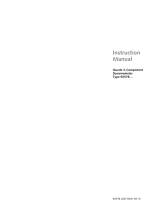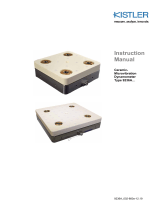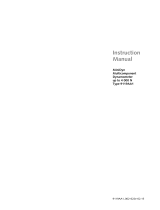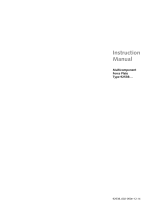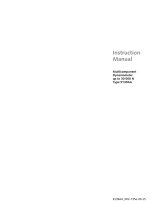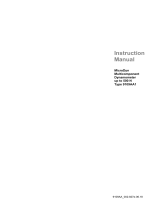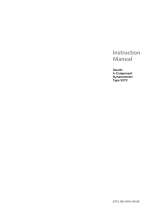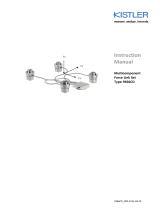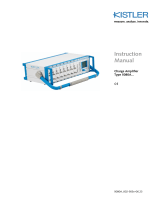Page is loading ...

Instruction
Manual
Multicomponent
Dynamometer
–
10 … 10 kN
Mounting Plate
90x105 mm
Type 9129AA
9129AA_002-442e-03.15

Instruction
Manual
Multicomponent
Dynamometer
–10 … 10 kN
Mounting Plate
90x105 mm
Type 9129AA
9129AA_002-442e-03.15


Foreword
9129AA_002-442e-03.15 Page 1
Foreword
Information in this document is subject to change without
notice. Kistler reserves the right to change or improve its
products and make changes in the content without obliga-
tion to notify any person or organization of such changes
or improvements.
©2009 … 2015 Kistler Group. All rights reserved. All rights
reserved. Except as expressly provided herein, no part of
this manual may be reproduced for any purpose without
the express prior written consent of Kistler Group.
Kistler Group
Eulachstrasse 22
8408 Winterthur
Switzerland
Tel. +41 52 224 11 11
Fax +41 52 224 14 14
www.kistler.com

Multicomponent Dynamometer, Type 9129AA
Page 2 9129AA_002-442e-03.15
Content
1. Introduction ................................................................................................................................... 4
2. Important Instruction ..................................................................................................................... 5
2.1 For Your Safety .................................................................................................................... 5
2.2 How to Treat the Instrument ................................................................................................ 6
2.3 Tips for Using the Instruction Manual .................................................................................. 7
2.4 What Happens After Modifications? .................................................................................... 7
3. General Description ....................................................................................................................... 8
3.1 What is a Multicomponent Dynamometer Used For? ........................................................... 8
3.2 Principle of Operation .......................................................................................................... 9
3.3 Design of the Dynamometer .............................................................................................. 10
4. Assembly, Installation and Putting Into Operation ...................................................................... 11
4.1 Important Remarks ............................................................................................................. 11
4.2 Installing the Dynamometer ............................................................................................... 12
4.3 Dynamometer Positioning .................................................................................................. 14
4.4 Basic Circuity and Cabling of the Measuring System .......................................................... 15
4.5 Measuring Chain ................................................................................................................ 15
4.6 Measuring System for 3-Component Measurement Fx, Fy, Fz .............................................. 16
4.7 3-Component Force Measurement .................................................................................... 17
4.8 Measuring System for 6-Component Measurement Fx, Fy, Fz, Mx, My, Mz .......................... 18
5. Operation ..................................................................................................................................... 20
5.1 Choosing Range ................................................................................................................. 20
5.2 Measuring Small Changes in Force ..................................................................................... 20
5.3 Useful Frequency Range ..................................................................................................... 22
5.4 Piezoelectric Force Measurement ....................................................................................... 24
5.5 Tips for Better Measurement Results .................................................................................. 27
5.6 Polarity of Measurement Signal .......................................................................................... 27
6. Maintenance ................................................................................................................................ 28
6.1 Recalibration of Sensor ....................................................................................................... 28
6.2 Maintenance Procedure ..................................................................................................... 29
7. Troubleshooting ........................................................................................................................... 30
7.1 Diagnosis and Rectification of Faults .................................................................................. 30
7.2 In the Case of a Faulty Dynamometer ................................................................................ 31
8. Technical Data ............................................................................................................................. 32
8.1 Dynamometer Type 9129AA.............................................................................................. 32
8.2 Dimensions of Dynamometer Type 9129AA ...................................................................... 33
8.3 Accessories ......................................................................................................................... 34

Introduction
9129AA_002-442e-03.15 Page 3
9. Annex ........................................................................................................................................... 36
9.1 Glossary .............................................................................................................................. 36
9.2 Measurement Uncertainty .................................................................................................. 40
9.3 Linearity .............................................................................................................................. 41
9.4 Frequency Range ................................................................................................................ 43
9.5 Influence of Temperature .................................................................................................... 44
10. Indexverzeichnis ........................................................................................................................... 46
Total pages: 46

Multicomponent Dynamometer, Type 9129AA
Page 4 9129AA_002-442e-03.15
1. Introduction
Please take the time to thoroughly read this instruction
manual. It will help you with the installation, maintenance,
and use of this product.
To the extent permitted by law Kistler does not accept any
liability if this instruction manual is not followed or prod-
ucts other than those listed under
Accessories
are used.
Kistler offers a wide range of products for use in measuring
technology:
Piezoelectric sensors for measuring force, torque, strain,
pressure, acceleration, shock, vibration and acoustic-
emission
Strain gage sensor systems for measuring force and
moment
Piezoresistive pressure sensors and transmitters
Signal conditioners, indicators and calibrators
Electronic control and monitoring systems as well as
software for specific measurement applications
Data transmission modules (telemetry)
Kistler also develops and produces measuring solutions for
the application fields engines, vehicles, manufacturing,
plastics and biomechanics sectors.
Our product and application brochures will provide you
with an overview of our product range. Detailed data
sheets are available for almost all products.
If you need additional help beyond what can be found ei-
ther on-line or in this manual, please contact Kistler's ex-
tensive support organization.

Important Instruction
9129AA_002-442e-03.15 Page 5
2. Important Instruction
It is absolutely essential to follow the instructions below,
which are intended to ensure your safety when working
with the instrument and guarantee a long, trouble-free
service life.
2.1 For Your Safety
This dynamometer has been thoroughly tested and left
the factory in perfectly safe condition. To maintain this
condition and ensure safe operation the user must fol-
low the instructions and warnings in this manual.
The dynamometer may only be mounted, operated and
maintained by persons familiar with it and suitably qual-
ified for their particular work.
If it has to be assumed that safe operation is no longer
possible, take the sensor out of service and safeguard it
against accidental reuse.
It must be assumed that safe operation is no longer
possible:
if the dynamometer is visibly damaged,
if the dynamometer no longer works,
after prolonged storage under adverse conditions
and
after being severely stressed in transit.
For cutting force measurements, mount the dynamome-
ter on the machine tool as specified. See Section 4.2
'Installing the Dynamometer' for details.
Fix all parts mounted on the top plate of the dynamom-
eter according to the forces expected!

Multicomponent Dynamometer, Type 9129AA
Page 6 9129AA_002-442e-03.15
2.2 How to Treat the Instrument
Only work with the dynamometer under the specified
environmental and operating conditions.
The insulation resistance of piezoelectric sensors is of
critical importance; it must be approximately 1014 (or at
least 1013) Ω. To achieve this value all connections must
be kept scrupulously clean and dry. The insulation re-
sistance can be measured with tester Type 5493.
Protect the connector of the sensor against dirt and
never touch the front of it with your fingers. Put the in-
cluded cover on whenever the connection is not being
used.
The cable for connecting the sensor to a charge amplifi-
er is a high-insulation type. Only use connecting cables
specified by Kistler.
Once connected to the sensor it should remain in place
if possible.
When not in use keep the sensor in the original packag-
ing to protect it.
When performing long-time measurements, make sure
that the temperature of the dynamometer remains as
constant as possible.

Important Instruction
9129AA_002-442e-03.15 Page 7
2.3 Tips for Using the Instruction Manual
We recommend you read through the entire manual thor-
oughly. However, if you cannot spare the time and are al-
ready familiar with Kistler dynamometers you can limit
yourself to the immediately required information.
We have tried to organize this manual clearly so the re-
quired information is easily accessible.
Please keep the manual in a safe place where it is readily
available at all times.
If you lose it please contact your Kistler distributor for
prompt replacement.
All of the information and instructions in this manual are
subject to change at any time without prior notification.
2.4 What Happens After Modifications?
Equipment modifications generally result in changes to the
instruction manual. Please contact your Kistler distributor
regarding the means of updating of your documentation in
this case.

Multicomponent Dynamometer, Type 9129AA
Page 8 9129AA_002-442e-03.15
3. General Description
3.1 What is a Multicomponent Dynamometer Used For?
The multicomponent force plate provides dynamic and
quasi-static measurement of the 3 orthogonal components
of a force (Fx, Fy, Fz) acting from any direction onto the top
plate.
With the aid of optional evaluation devices the 3 moments
Mx, My and Mz can be measured as well.
The force plate has high rigidity and hence high natural
frequency. The high resolution enables very small dynamic
changes to be measured in large forces.
The dynamometer measures the active force regardless of
its application point. Both the average value of the force
and the dynamic force increase may be measured. The us-
able frequency range depends mainly on the resonance
frequency of the entire measuring rig.
Fig. 1: Type 9129AA
Typical applications
Measuring cutting forces involved in precision machin-
ing
Multicomponent force measurement
Measuring forces in confined spaces
Measuring the three cutting forces Fc, Ff and Fp involved
in boring and external turning with turret lathes (see
data sheet 9129A_000-710e for Type 9129A...)

General Description
9129AA_002-442e-03.15 Page 9
3.2 Principle of Operation
The force to be measured is introduced through a cover
plate and distributed over the sensor arranged between
cover and base plate.
Each force sensor contains three pairs of quartz plates, one
of which is sensitive to compression in the z-direction and
the other two to shear in the x- and y-directions respec-
tively. Measurement is virtually displacement-free.
The force introduced into the sensor is split into three
components.
Fig. 2: Arrangement of force sensors in multicomponent
dynamometer: pairs of quartz crystal washers for
the three measurement directions
In the force measurement with 3 components, the individ-
ual signals are fed together in the connecting cable.
Depending on the direction of the force, positive or nega-
tive charges develop at the connections. Negative charges
result in positive voltages at the output of the change am-
plifier and vice versa.

Multicomponent Dynamometer, Type 9129AA
Page 10 9129AA_002-442e-03.15
3.3 Design of the Dynamometer
The dynamometer consists of four 3-component force sen-
sors which are mounted under high preload between the
cover plate and the two lateral base plates.
This preload is necessary for transmission of the friction
forces.
1 2 1 3
The four force sensors are mounted ground-insulated.
Ground loop problems are largely eliminated consequently.
The dynamometer is rustproof and protected against in-
gress of splash water and coolant. Together with the con-
necting cable (Type 1687B... or 1677A…) the dynamome-
ter meets the requirements of degree of protection IP67.
The special sensor arrangement and signal connection en-
sure that the dynamometer is insensitive to temperature in-
fluences to the greatest possible extent.
1 Base plates
2 Cover plate
3 Connector

Assembly, Installation and Putting Into Operation
9129AA_002-442e-03.15 Page 11
4. Assembly, Installation and Putting Into Operation
4.1 Important Remarks
The multicomponent dynamometer Type 9129AA is a pre-
cision instrument, but its inherent accuracy can be exploit-
ed and retained only if it is treated with care. The following
rules should therefore be noted:
Never drop the dynamometer or expose it to heavy im-
pacts! The maximum force of a shock of this kind could
exceed the measuring range of the instrument and
cause permanent deformations.
Never use a hammer to position the workpieces, as
such blows might also cause deformation!
On the following chapters you will find information for in-
stalling the dynamometer and basic information on the
layout of the measuring system.

Multicomponent Dynamometer, Type 9129AA
Page 12 9129AA_002-442e-03.15
4.2 Installing the Dynamometer
To install the force plate correctly please observe the fol-
lowing points:
The dynamometer must be installed only by persons
familiar with the device and sufficiently qualified for this
work.
Connect the connecting cable first to the dynamometer.
Both connecting sides (dynamometer and cable) must
be cleaned with cleaning and insulation spray Type
1003. The O-ring is fitted to seal the connection. The
contact surfaces for the O-ring must be clean. Insert the
O-ring and bolt the flange of the cable to the summing
box with the two bolts and tighten until it fits.
Tightening torque (MA): 4,5 N·m
Before installing the dynamometer on a machine tool or
a test rig check the flatness of the installation surface.
Uneven contact surfaces cause internal distortions
which expose the individual force sensor to additional
strong axial load and can increase crosstalk.
Fig. 3: Mounting of cable with O-ring seal
Cable
Screw M4x10

Assembly, Installation and Putting Into Operation
9129AA_002-442e-03.15 Page 13
The bearing surfaces of the load sensing device (bases) are
finely machined. The device must therefore be installed on-
ly on surfaces which are ground or finished to comparable
standard. The specific alignment of the force sensors de-
mands extremely careful monitoring of the quality of the
mounting surfaces. Clean the bearing surfaces thoroughly
before assembling.
Make sure that the force plate rests absolutely flat.
Even the smallest air gap will cause undesirable elastici-
ty and reduce the resonant frequency of the measuring
rig. All mountings must therefore be considered from
the vibration aspect also.
Whenever possible, the connecting cable should be left
connected permanently to the dynamometer.
The two long sides of the base plates or the long sides of
the cover plate are used to align the dynamometer on a
magnetic plate or the table of the machining center.
Alignment surfaces on base plates
Alignment surfaces on cover plate

Multicomponent Dynamometer, Type 9129AA
Page 14 9129AA_002-442e-03.15
There are two different ways of mounting the dynamome-
ter.
a. With eight M6x35 screws
This method requires eight M6 threaded holes (mini-
mum thread reach: 12 mm) on the table. Each screw
must be tightened to a torque of 15 N·m, screw grade
12,9.
b. On a magnetic plate
A magnetic plate can be used to avoid any need to
adapt the lathe by drilling supplementary holes in its
table.
Caution!
This method can only be used if the process forces do not
exceed the magnetic forces. It is absolutely essential to
avoid the dynamometer slipping.
4.3 Dynamometer Positioning
The dynamometer and the cables must be positioned so
that coolants can drain completely. This stops aggres-
sive bacteria forming in old coolant, which could then
damage the dynamometer and the cables. Depressions
and creases should therefore be avoided
Install the connecting cable so that it can neither shear
off nor be pulled out when working
Hexagon socket screw
Tightening torque 15 N·m

Assembly, Installation and Putting Into Operation
9129AA_002-442e-03.15 Page 15
4.4 Basic Circuity and Cabling of the Measuring System
The electrical charge (pC) supplied by the dynamometer
are converted by charge amplifiers into proportional volt-
ages which can be displayed, recorded and processed with
the usual instruments.
Please note the following as regards connecting the
measuring system:
The connecting cables from the dynamometer to the
charge amplifier must have a high level of insulation
and a low level of frictional electricity. Only the recom-
mended connecting cables should therefore be used.
Ordinary cables can be used for the connection be-
tween the charge amplifiers and the display and evalua-
tion instruments.
All electrical connections must be made cleanly and
with care. The connection cover caps should not be re-
moved until immediately before connecting the cable.
Please follow the instructions for cabling specific con-
figurations in the two following sections.
4.5 Measuring Chain
1) See data sheet entitled Cables for Multicomponent Force Sensors, Dynamometers and Force Plates 1687B_000-545
2) See data sheet entitled Multichannel Charge Amplifiers for Multicomponent Force Measurement 5070A_000-485

Multicomponent Dynamometer, Type 9129AA
Page 16 9129AA_002-442e-03.15
4.6 Measuring System for 3-Component Measurement Fx, Fy, Fz
The following diagram shows the elements required for
connecting the dynamometer to a multichannel charge am-
plifier (e.g. Type 5070Ax01xx) for 3-component measure-
ment. This measuring chain is ground-isolated and uses a 3-
core cable.
Type 9129AA Connecting cable Multichannel charge amplifier
Type 1687B5 Type 5070Ax01xx
Fig. 4: Measuring System for 3-Component Measurement
Fx, Fy, Fz
Fig. 5: Cable diagram connecting cable Type 1687B5
Input Signals Pin No.
Ground 1
X1 + 2 2
X3 + 4 3
Y1 + 4 4
Y2 + 3 5
Z1 6
Z2 7
Z3 8
Z4 9
Pin No. Output signals
1 Ground
2 Fx
3 –
4 Fy
5 –
6 Fz
7 –
8 –
9 –
In
p
u
t
Out
p
u
t

Assembly, Installation and Putting Into Operation
9129AA_002-442e-03.15 Page 17
4.7 3-Component Force Measurement
The form of dynamometer construction ensures the acting
forces do not exert any moments on the individual force
link. The force link can therefore be loaded (without any
moments) up to the maximum defined measuring range.
However, a force whose line of action does not pass
through the zero of the dynamometer produces a moment
relative to this zero. These moments cause the sensors to
be subjected to an additional load in one or more direc-
tions.
For 3-component force measurement with a dynamometer
consisting of four 3-component force links, the output sig-
nals (Fx, Fy and Fz in each case) of these links are summed.
However, irrespective of the force application point, the
sum of the four force links always indicates the correct val-
ue.
A 3-component dynamometer measures the magnitude
and direction of the three components of the forces acting
on a dynamometer, but not their spatial location.
Depending on the position of the force application point,
the load is either distributed between all four force links or
an individual force link can take most of it. If the force acts
well outside the force plate, lever action can cause an indi-
vidual force link to be subjected to a multiple of the force
to be measured. For such applications the load on an indi-
vidual force link must be accurately calculated.
The measuring range of a force plate is given by the fol-
lowing rule of thumb:
If the point of application of the resultant force vector lies
within a pyramid formed by the surface of the cover plate
and having a height corresponding to the shorter side of
this plate, the maximum measuring range of an individual
force sensor applies.
If there is a possibility of the acting loads damaging the
dynamometer, please contact your Kistler Customer Service
Center, where an analysis can be carried out for your load
case.
/
